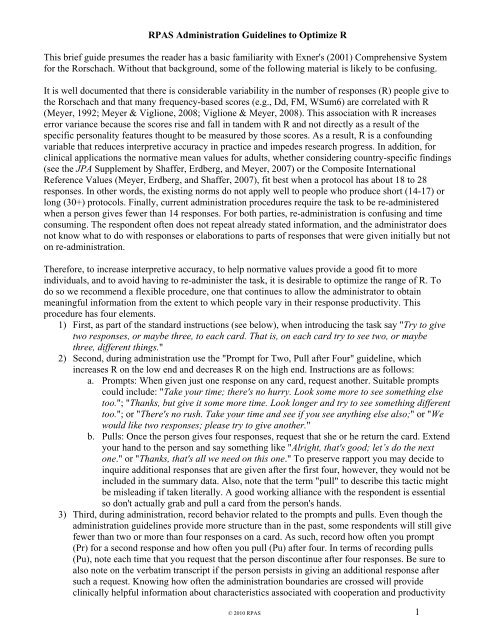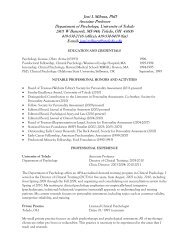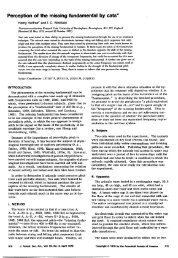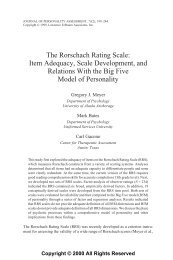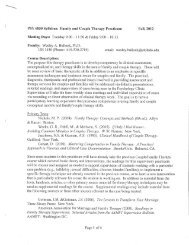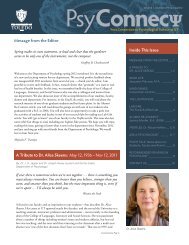1 RPAS Administration Guidelines to Optimize R This ... - Psychology
1 RPAS Administration Guidelines to Optimize R This ... - Psychology
1 RPAS Administration Guidelines to Optimize R This ... - Psychology
Create successful ePaper yourself
Turn your PDF publications into a flip-book with our unique Google optimized e-Paper software.
<strong>RPAS</strong> <strong>Administration</strong> <strong>Guidelines</strong> <strong>to</strong> <strong>Optimize</strong> R<br />
<strong>This</strong> brief guide presumes the reader has a basic familiarity with Exner's (2001) Comprehensive System<br />
for the Rorschach. Without that background, some of the following material is likely <strong>to</strong> be confusing.<br />
It is well documented that there is considerable variability in the number of responses (R) people give <strong>to</strong><br />
the Rorschach and that many frequency-based scores (e.g., Dd, FM, WSum6) are correlated with R<br />
(Meyer, 1992; Meyer & Viglione, 2008; Viglione & Meyer, 2008). <strong>This</strong> association with R increases<br />
error variance because the scores rise and fall in tandem with R and not directly as a result of the<br />
specific personality features thought <strong>to</strong> be measured by those scores. As a result, R is a confounding<br />
variable that reduces interpretive accuracy in practice and impedes research progress. In addition, for<br />
clinical applications the normative mean values for adults, whether considering country-specific findings<br />
(see the JPA Supplement by Shaffer, Erdberg, and Meyer, 2007) or the Composite International<br />
Reference Values (Meyer, Erdberg, and Shaffer, 2007), fit best when a pro<strong>to</strong>col has about 18 <strong>to</strong> 28<br />
responses. In other words, the existing norms do not apply well <strong>to</strong> people who produce short (14-17) or<br />
long (30+) pro<strong>to</strong>cols. Finally, current administration procedures require the task <strong>to</strong> be re-administered<br />
when a person gives fewer than 14 responses. For both parties, re-administration is confusing and time<br />
consuming. The respondent often does not repeat already stated information, and the administra<strong>to</strong>r does<br />
not know what <strong>to</strong> do with responses or elaborations <strong>to</strong> parts of responses that were given initially but not<br />
on re-administration.<br />
Therefore, <strong>to</strong> increase interpretive accuracy, <strong>to</strong> help normative values provide a good fit <strong>to</strong> more<br />
individuals, and <strong>to</strong> avoid having <strong>to</strong> re-administer the task, it is desirable <strong>to</strong> optimize the range of R. To<br />
do so we recommend a flexible procedure, one that continues <strong>to</strong> allow the administra<strong>to</strong>r <strong>to</strong> obtain<br />
meaningful information from the extent <strong>to</strong> which people vary in their response productivity. <strong>This</strong><br />
procedure has four elements.<br />
1) First, as part of the standard instructions (see below), when introducing the task say "Try <strong>to</strong> give<br />
two responses, or maybe three, <strong>to</strong> each card. That is, on each card try <strong>to</strong> see two, or maybe<br />
three, different things."<br />
2) Second, during administration use the "Prompt for Two, Pull after Four" guideline, which<br />
increases R on the low end and decreases R on the high end. Instructions are as follows:<br />
a. Prompts: When given just one response on any card, request another. Suitable prompts<br />
could include: "Take your time; there's no hurry. Look some more <strong>to</strong> see something else<br />
<strong>to</strong>o."; "Thanks, but give it some more time. Look longer and try <strong>to</strong> see something different<br />
<strong>to</strong>o."; or "There's no rush. Take your time and see if you see anything else also;" or "We<br />
would like two responses; please try <strong>to</strong> give another."<br />
b. Pulls: Once the person gives four responses, request that she or he return the card. Extend<br />
your hand <strong>to</strong> the person and say something like "Alright, that's good; let’s do the next<br />
one." or "Thanks, that's all we need on this one." To preserve rapport you may decide <strong>to</strong><br />
inquire additional responses that are given after the first four, however, they would not be<br />
included in the summary data. Also, note that the term "pull" <strong>to</strong> describe this tactic might<br />
be misleading if taken literally. A good working alliance with the respondent is essential<br />
so don't actually grab and pull a card from the person's hands.<br />
3) Third, during administration, record behavior related <strong>to</strong> the prompts and pulls. Even though the<br />
administration guidelines provide more structure than in the past, some respondents will still give<br />
fewer than two or more than four responses on a card. As such, record how often you prompt<br />
(Pr) for a second response and how often you pull (Pu) after four. In terms of recording pulls<br />
(Pu), note each time that you request that the person discontinue after four responses. Be sure <strong>to</strong><br />
also note on the verbatim transcript if the person persists in giving an additional response after<br />
such a request. Knowing how often the administration boundaries are crossed will provide<br />
clinically helpful information about characteristics associated with cooperation and productivity<br />
© 2010 <strong>RPAS</strong> 1
when they are low (e.g., resistance or limited resources) and high (e.g., fluid, affectively driven<br />
responding).<br />
4) Fourth, <strong>to</strong> help ensure a sufficient pool of responses for interpretation, if you do not obtain 14 or<br />
more responses initially, retain all the initial responses but go through all cards again with<br />
encouragement for the respondent <strong>to</strong> give a few more responses. Unlike standard CS<br />
administration, use the responses from the first administration but administer the cards again and<br />
collect the extra responses that are spontaneously given. Once this is done, complete the inquiry<br />
based on the order of the responses within a card, not the order in which the responses were<br />
obtained. Although it is quite unlikely <strong>to</strong> occur, if the respondent produces fewer than 16<br />
responses say something like:<br />
a. "That was fine. However, we need a few more responses in order for this test <strong>to</strong> be most<br />
helpful. So let's go through the cards again. Take your time when looking at them. I'm<br />
sure you will be able <strong>to</strong> see some more things." Hand the respondent, the first card and<br />
say, "What else might this be?" Say this only once. During this second administration no<br />
prompts or pulls are given. Rejections are accepted. Although this approach complicates<br />
how a sequence analysis interpretation would be conducted, it reduces demands on the<br />
examinee compared <strong>to</strong> redoing the whole test and this is likely <strong>to</strong> preserve the alliance<br />
and reduce the added frustration or discouragement that could affect their scores on a<br />
second administration.<br />
When it is time <strong>to</strong> administer the Rorschach, say the following, "Now we are going <strong>to</strong> take the inkblot<br />
test. I will hand the inkblots <strong>to</strong> you one at a time and your task is <strong>to</strong> look at each card <strong>to</strong> answer the<br />
question "What might this be?" Does that make sense?" If the answer is no, find out what is unclear and<br />
address the issue. If the answer is yes, say the following: "Good. We can get started then. Try <strong>to</strong> give<br />
two responses, or maybe three, <strong>to</strong> each card. That is, for each card try <strong>to</strong> see two, or maybe three,<br />
different things." Next, hand Card I in the upright position <strong>to</strong> the respondent and say just the following<br />
four words: "What might this be?"<br />
Use clinical judgment <strong>to</strong> balance the need for consistent administration guidelines and the need for<br />
personal rapport and a good working alliance with the respondent. For instance, although we note that it<br />
may make sense <strong>to</strong> inquire one or several responses that happen <strong>to</strong> come after the fourth, if a respondent<br />
consistently gives extra responses, it may be most reasonable <strong>to</strong> explain at the start of the inquiry that<br />
you will only be asking about the first four <strong>to</strong> each card.<br />
Research on an early version of the "Prompt for Two, Pull after Four" guideline showed that it<br />
eliminated the need <strong>to</strong> re-administer the test because of short pro<strong>to</strong>cols and it increased the validity of<br />
Rorschach measures of thought disorder and psychosis (Dean, Viglione, Perry, & Meyer, 2007).<br />
© 2010 <strong>RPAS</strong> 2


